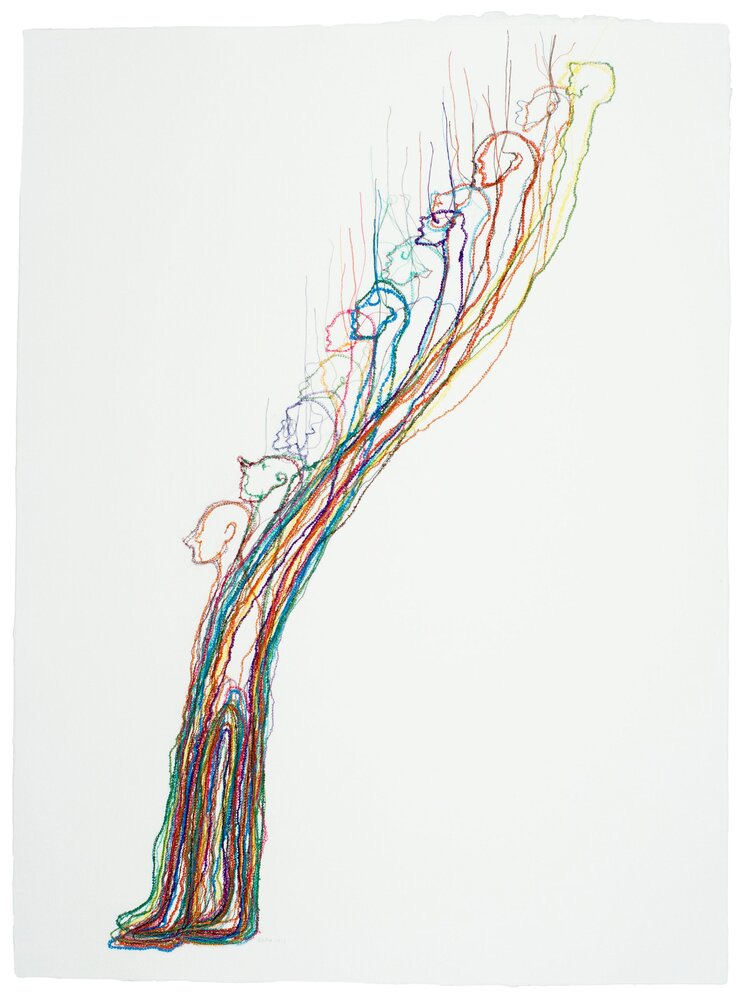Being a human will break your heart. And if you’re lucky, if you live a long life, it will break your heart over and over and over again.
The challenge is stitching ourselves back together each time—weaker now in some places and stronger in others—trying to prevent hardness or bitterness from annexing parts of ourselves that were once soft and open.
When I look up the word resiliency, I see that its synonyms are: toughness, strength, and durability. These qualities keep us bolstered and buttressed, providing ballast for the soul when the roughest winds blow through. The other synonyms for resiliency are: elasticity, flexibility, and give. This is where the real magic lies. Pain wants to calcify inside of us. Resiliency not only makes us strong, it keeps us nimble, responsive, and vulnerable—able to yield to pain before it can put down stakes.
It occurred to me recently that when we refer to a creative practice, what we’re actually practicing is resiliency.
Time in the studio acts as a mirror to life: we make lots of plans for ourselves and then we attend to the happy accidents and the catastrophic failures that ensue. Sometimes we make no plans at all and simply watch the creative force become tangible through our hands. We hurt ourselves, often literally with sharp or hot objects, and then we heal. Things are destroyed in accidents and we grieve the pieces of ourselves that lived inside of them. We achieve things we didn’t think were possible, often after grave disappointment or having let ourselves down. We celebrate.
The practice is one of returning. To ourselves, to our work, to the creative force that makes it all possible. We return when we are are sad or discouraged or heartbroken. (And when we are impossibly happy.) We practice getting back up, over and over again.
When we cite statistics about the importance of art to society, it usually goes like this:
The creative industries generate $763.6 billion in economic activity and account for 4.2% of our nation's gross domestic product.
The arts yield $27.5 billion in revenue to federal, state, county and municipal governments.
Public funding for the arts yields additional financial commitments, leveraging $9 in private and earned matching funds for every $1 invested by the government.
These are all essential, quantitative ways in which art provides for us. But we must also talk about how the practice of resiliency in artmaking contributes, qualitatively, to our collective well-being. Resiliency ripples outward. The higher a person’s resiliency quotient, the more compassionate and less reactive they become when things get hard. And that benefits everyone with whom they come into contact, loved ones and strangers alike.
Unfortunately, most of the qualities that affect one’s resiliency quotient—genetics, environment, trauma, natural disposition, and early attachment to caregivers—are beyond one’s control. In large part, our level of resiliency is dictated by the events of our lives, the many cosmic rolls of the dice, for better and for worse.
A creative practice, though, gives us the opportunity to cultivate qualities that help us become simultaneously stronger and more flexible. It gives us a reason to return, again and again, over and over, to ourselves and to each other.
Reflections and Correspondence
After my last post, about the spaces between things, I received an email from composer Lisa DeGrace who said it had made her think about one of her compositions. I wanted to share, with her permission, some of what she wrote:
“There is a ‘pause’ at around 3:24, and honestly... I have always believed that the pause should be at least 3 - 5 seconds longer- it should be uncomfortably long... BUT... I always worried that a listener who was not looking specifically at track length would hear the pause and think the song was totally over. When really - IMO- the best part of the song is still to come. So, my sacrifice was to make the pause be really way too short- to meet the most impatient listener.”
Though I’ve thought endlessly about how the ever-shortened attention of the viewer has shaped contemporary visual culture, I’d never considered how it affected musicians and composers. How much, I wonder, do we lose everyday to our own shattered patience without even realizing the loss?






What beautiful writing about a vital part of life and a deeply meaningful way to see it made real. Thank you for reminding us, yet again, that art and creative practices impact our lives in more ways than we can count. And that they do so at a visceral level. Just what my heart needed today. 💜
Over the last week of December I suddenly and unexpectedly lost my aunt. It was (and is) completely devastating. This is the first time I have lost someone this close to me, so the grieving process was unexpected and confusing, and I found myself at a total loss for a while. I have an upcoming First Thursday show in Feb and I hadn't started on it, and almost didn't want to. But once I got started with the work, the pain was a little easier to carry, and as I spend more time with it, I'm able to understand it a little better. It's still horrible and weird and amorphous, but its becoming something less powerful and overwhelming, which I largely attribute to my creative outlets. I think I really needed this article, thank you for your words.